child restraint JEEP COMPASS 2021 Owner handbook (in English)
[x] Cancel search | Manufacturer: JEEP, Model Year: 2021, Model line: COMPASS, Model: JEEP COMPASS 2021Pages: 328, PDF Size: 8.85 MB
Page 8 of 328
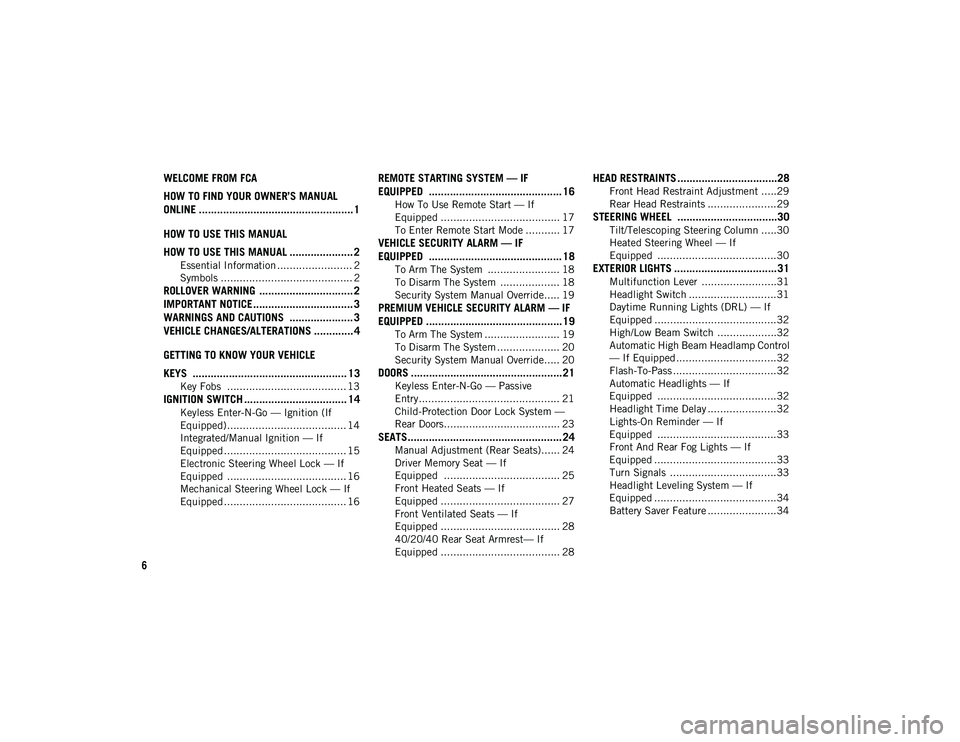
6
WELCOME FROM FCA
HOW TO FIND YOUR OWNER’S MANUAL
ONLINE ................................................... 1
HOW TO USE THIS MANUAL
HOW TO USE THIS MANUAL ..................... 2
Essential Information ........................ 2
Symbols .......................................... 2
ROLLOVER WARNING ............................... 2
IMPORTANT NOTICE ................................. 3
WARNINGS AND CAUTIONS ..................... 3
VEHICLE CHANGES/ALTERATIONS ............. 4
GETTING TO KNOW YOUR VEHICLE
KEYS ................................................... 13
Key Fobs ...................................... 13
IGNITION SWITCH .................................. 14
Keyless Enter-N-Go — Ignition (If
Equipped)...................................... 14 Integrated/Manual Ignition — If
Equipped ....................................... 15 Electronic Steering Wheel Lock — If
Equipped ...................................... 16 Mechanical Steering Wheel Lock — If
Equipped ....................................... 16
REMOTE STARTING SYSTEM — IF
EQUIPPED ............................................ 16
How To Use Remote Start — If
Equipped ...................................... 17 To Enter Remote Start Mode ........... 17
VEHICLE SECURITY ALARM — IF
EQUIPPED ............................................ 18
To Arm The System ....................... 18
To Disarm The System ................... 18
Security System Manual Override..... 19
PREMIUM VEHICLE SECURITY ALARM — IF
EQUIPPED .............................................19
To Arm The System ........................ 19
To Disarm The System .................... 20
Security System Manual Override..... 20
DOORS ..................................................21
Keyless Enter-N-Go — Passive
Entry............................................. 21 Child-Protection Door Lock System —
Rear Doors..................................... 23
SEATS................................................... 24
Manual Adjustment (Rear Seats)...... 24
Driver Memory Seat — If
Equipped ..................................... 25 Front Heated Seats — If
Equipped ...................................... 27 Front Ventilated Seats — If
Equipped ...................................... 28 40/20/40 Rear Seat Armrest— If
Equipped ...................................... 28
HEAD RESTRAINTS .................................28
Front Head Restraint Adjustment .....29
Rear Head Restraints ......................29
STEERING WHEEL .................................30
Tilt/Telescoping Steering Column .....30
Heated Steering Wheel — If
Equipped ......................................30
EXTERIOR LIGHTS ..................................31
Multifunction Lever ........................31
Headlight Switch ............................31
Daytime Running Lights (DRL) — If
Equipped .......................................32 High/Low Beam Switch ...................32
Automatic High Beam Headlamp Control
— If Equipped ................................32 Flash-To-Pass .................................32
Automatic Headlights — If
Equipped ......................................32 Headlight Time Delay ......................32
Lights-On Reminder — If
Equipped ......................................33 Front And Rear Fog Lights — If
Equipped .......................................33 Turn Signals ..................................33
Headlight Leveling System — If
Equipped .......................................34 Battery Saver Feature ......................34
2020_JEEP_M6_UG_UK.book Page 6
Page 10 of 328

8
OCCUPANT RESTRAINT SYSTEMS .......... 90
Occupant Restraint Systems
Features ....................................... 90 Important Safety Precautions ........... 90
Seat Belt Systems ......................... 91
Supplemental Restraint Systems
(SRS) ............................................ 98 Child Restraints — Carrying Children
Safely.......................................... 114 Transporting Pets ........................ 127
SAFETY TIPS ...................................... 128
Transporting Passengers ................ 128
Exhaust Gas ................................. 128
Safety Checks You Should Make Inside
The Vehicle ................................. 128 Periodic Safety Checks You Should Make
Outside The Vehicle ...................... 130
STARTING AND OPERATING
STARTING THE ENGINE......................... 131
Normal Starting — Gasoline
Engine......................................... 131 Stopping The Engine..................... 133
Normal Starting — Diesel Engine ... 133
PARK BRAKE ....................................... 134
Electric Park Brake (EPB) ............. 134
MANUAL TRANSMISSION — IF
EQUIPPED ..........................................137
Shifting ....................................... 137
Downshifting ............................... 138
Parking ....................................... 139
AUTOMATIC TRANSMISSION — IF
EQUIPPED ...........................................139
Ignition Park Interlock .................. 140
Brake/Transmission Shift Interlock
System ........................................ 140 Nine-Speed Automatic
Transmission .............................. 140
FOUR-WHEEL DRIVE OPERATION — IF
EQUIPPED ...........................................146
Jeep Active Drive ......................... 146
SELEC-TERRAIN — IF EQUIPPED ...........147
Mode Selection Guide................... 147
STOP/START SYSTEM — IF EQUIPPED ..148
Operating Modes .......................... 148
Manual Activation / Deactivation .... 149
ACTIVE SPEED LIMITER — IF
EQUIPPED ..........................................149
Activation .................................... 149
Exceeding The Set Speed.............. 150
Deactivation ................................ 150
SPEED CONTROL — IF EQUIPPED .........150
To Activate .................................. 151
To Set A Desired Speed ................ 151
To Resume Speed ....................... 151
To Deactivate .............................. 151
ADAPTIVE CRUISE CONTROL (ACC) — IF
EQUIPPED............................................151
To Activate/Deactivate ...................152
To Set A Desired ACC Speed ..........152
To Resume ...................................152
To Vary The Speed Setting .............153
Setting The Following Distance In
ACC .............................................154
PARKSENSE REAR PARK ASSIST — IF
EQUIPPED ...........................................154
ParkSense Sensors ........................154
ParkSense Warning Display ............154
Enabling And Disabling
ParkSense ....................................155 ParkSense System Usage
Precautions ..................................155
PARKSENSE FRONT AND REAR PARK ASSIST
— IF EQUIPPED ..................................156
ParkSense Sensors ........................156
Enabling And Disabling
ParkSense ....................................157 Side Distance Warning System .......157
PARKSENSE ACTIVE PARK ASSIST SYSTEM
— IF EQUIPPED ...................................159
Enabling And Disabling The ParkSense
Active Park Assist System ..............159 Exiting The Parking Space .............160
2020_JEEP_M6_UG_UK.book Page 8
Page 26 of 328
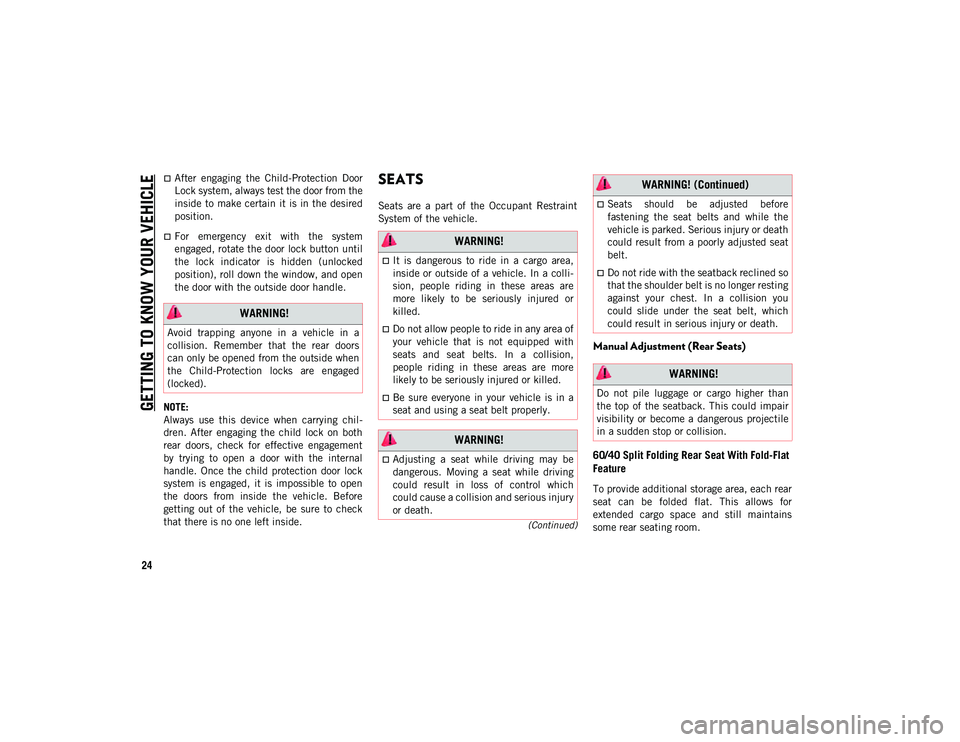
GETTING TO KNOW YOUR VEHICLE
24
(Continued)
After engaging the Child-Protection Door
Lock system, always test the door from the
inside to make certain it is in the desired
position.
For emergency exit with the system
engaged, rotate the door lock button until
the lock indicator is hidden (unlocked
position), roll down the window, and open
the door with the outside door handle.
NOTE:
Always use this device when carrying chil -
dren. After engaging the child lock on both
rear doors, check for effective engagement
by trying to open a door with the internal
handle. Once the child protection door lock
system is engaged, it is impossible to open
the doors from inside the vehicle. Before
getting out of the vehicle, be sure to check
that there is no one left inside.
SEATS
Seats are a part of the Occupant Restraint
System of the vehicle.
Manual Adjustment (Rear Seats)
60/40 Split Folding Rear Seat With Fold-Flat
Feature
To provide additional storage area, each rear
seat can be folded flat. This allows for
extended cargo space and still maintains
some rear seating room.
WARNING!
Avoid trapping anyone in a vehicle in a
collision. Remember that the rear doors
can only be opened from the outside when
the Child-Protection locks are engaged
(locked).
WARNING!
It is dangerous to ride in a cargo area,
inside or outside of a vehicle. In a colli -
sion, people riding in these areas are
more likely to be seriously injured or
killed.
Do not allow people to ride in any area of
your vehicle that is not equipped with
seats and seat belts. In a collision,
people riding in these areas are more
likely to be seriously injured or killed.
Be sure everyone in your vehicle is in a
seat and using a seat belt properly.
WARNING!
Adjusting a seat while driving may be
dangerous. Moving a seat while driving
could result in loss of control which
could cause a collision and serious injury
or death.
Seats should be adjusted before
fastening the seat belts and while the
vehicle is parked. Serious injury or death
could result from a poorly adjusted seat
belt.
Do not ride with the seatback reclined so
that the shoulder belt is no longer resting
against your chest. In a collision you
could slide under the seat belt, which
could result in serious injury or death.
WARNING!
Do not pile luggage or cargo higher than
the top of the seatback. This could impair
visibility or become a dangerous projectile
in a sudden stop or collision.
WARNING! (Continued)
2020_JEEP_M6_UG_UK.book Page 24
Page 30 of 328
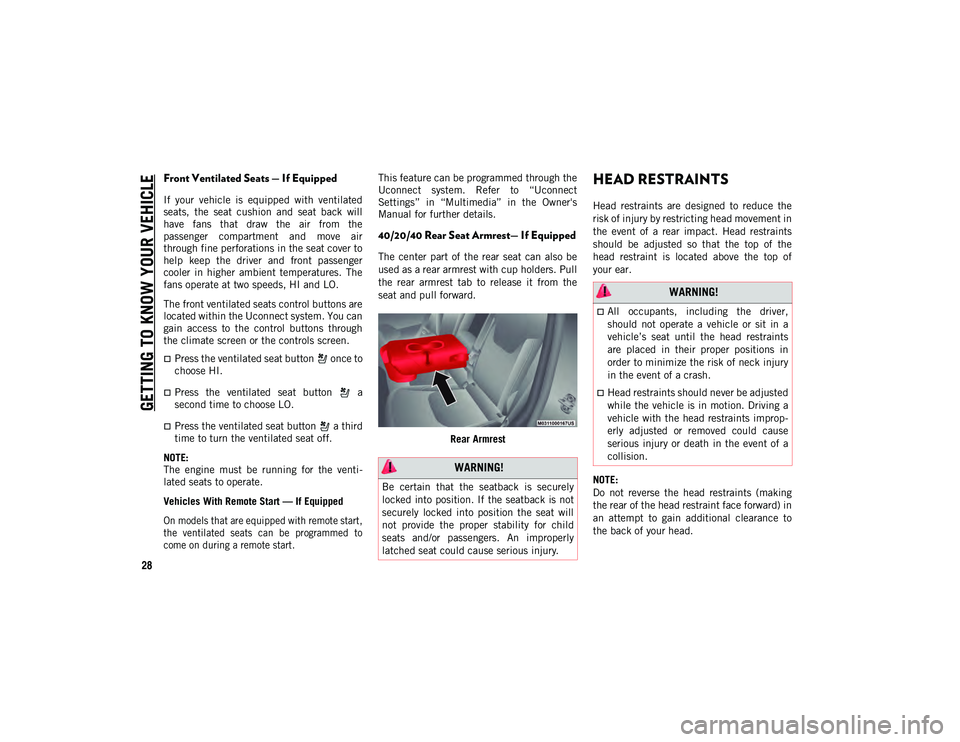
GETTING TO KNOW YOUR VEHICLE
28
Front Ventilated Seats — If Equipped
If your vehicle is equipped with ventilated
seats, the seat cushion and seat back will
have fans that draw the air from the
passenger compartment and move air
through fine perforations in the seat cover to
help keep the driver and front passenger
cooler in higher ambient temperatures. The
fans operate at two speeds, HI and LO.
The front ventilated seats control buttons are
located within the Uconnect system. You can
gain access to the control buttons through
the climate screen or the controls screen.
Press the ventilated seat button once to
choose HI.
Press the ventilated seat button a
second time to choose LO.
Press the ventilated seat button a third
time to turn the ventilated seat off.
NOTE:
The engine must be running for the venti -
lated seats to operate.
Vehicles With Remote Start — If Equipped
On models that are equipped with remote start,
the ventilated seats can be programmed to
come on during a remote start.
This feature can be programmed through the
Uconnect system. Refer to “Uconnect
Settings” in “Multimedia” in the Owner's
Manual for further details.
40/20/40 Rear Seat Armrest— If Equipped
The center part of the rear seat can also be
used as a rear armrest with cup holders. Pull
the rear armrest tab to release it from the
seat and pull forward.
Rear Armrest
HEAD RESTRAINTS
Head restraints are designed to reduce the
risk of injury by restricting head movement in
the event of a rear impact. Head restraints
should be adjusted so that the top of the
head restraint is located above the top of
your ear.
NOTE:
Do not reverse the head restraints (making
the rear of the head restraint face forward) in
an attempt to gain additional clearance to
the back of your head.
WARNING!
Be certain that the seatback is securely
locked into position. If the seatback is not
securely locked into position the seat will
not provide the proper stability for child
seats and/or passengers. An improperly
latched seat could cause serious injury.
WARNING!
All occupants, including the driver,
should not operate a vehicle or sit in a
vehicle’s seat until the head restraints
are placed in their proper positions in
order to minimize the risk of neck injury
in the event of a crash.
Head restraints should never be adjusted
while the vehicle is in motion. Driving a
vehicle with the head restraints improp -
erly adjusted or removed could cause
serious injury or death in the event of a
collision.
2020_JEEP_M6_UG_UK.book Page 28
Page 92 of 328
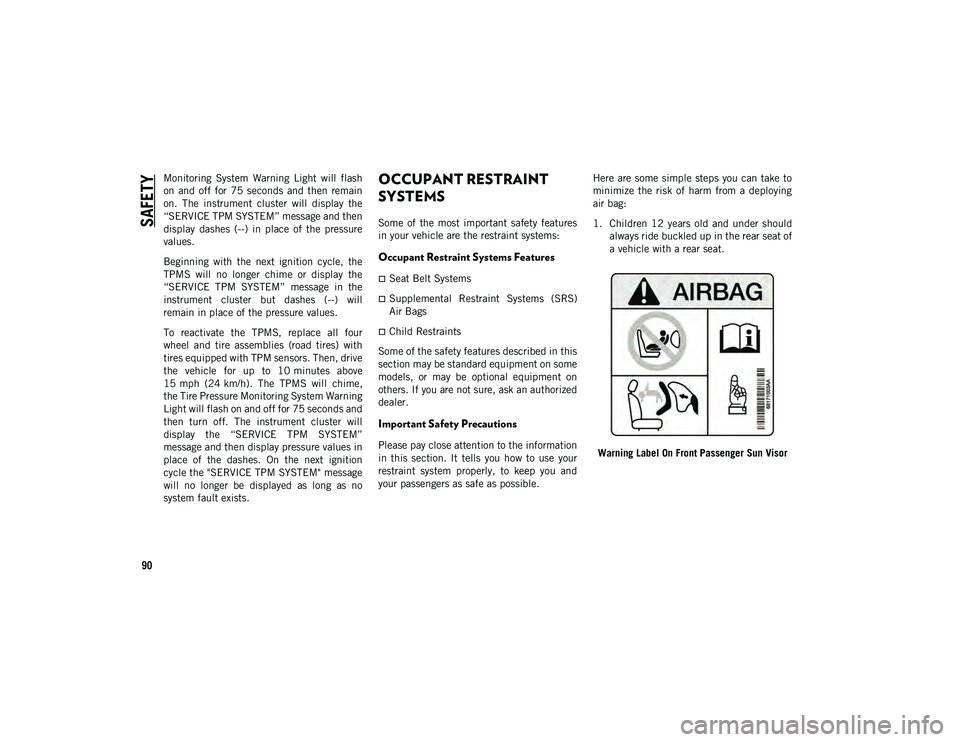
SAFETY
90
Monitoring System Warning Light will flash
on and off for 75 seconds and then remain
on. The instrument cluster will display the
“SERVICE TPM SYSTEM” message and then
display dashes (--) in place of the pressure
values.
Beginning with the next ignition cycle, the
TPMS will no longer chime or display the
“SERVICE TPM SYSTEM” message in the
instrument cluster but dashes (--) will
remain in place of the pressure values.
To reactivate the TPMS, replace all four
wheel and tire assemblies (road tires) with
tires equipped with TPM sensors. Then, drive
the vehicle for up to 10 minutes above
15 mph (24 km/h). The TPMS will chime,
the Tire Pressure Monitoring System Warning
Light will flash on and off for 75 seconds and
then turn off. The instrument cluster will
display the “SERVICE TPM SYSTEM”
message and then display pressure values in
place of the dashes. On the next ignition
cycle the "SERVICE TPM SYSTEM" message
will no longer be displayed as long as no
system fault exists.OCCUPANT RESTRAINT
SYSTEMS
Some of the most important safety features
in your vehicle are the restraint systems:
Occupant Restraint Systems Features
Seat Belt Systems
Supplemental Restraint Systems (SRS)
Air Bags
Child Restraints
Some of the safety features described in this
section may be standard equipment on some
models, or may be optional equipment on
others. If you are not sure, ask an authorized
dealer.
Important Safety Precautions
Please pay close attention to the information
in this section. It tells you how to use your
restraint system properly, to keep you and
your passengers as safe as possible. Here are some simple steps you can take to
minimize the risk of harm from a deploying
air bag:
1. Children 12 years old and under should
always ride buckled up in the rear seat of
a vehicle with a rear seat.
Warning Label On Front Passenger Sun Visor
2020_JEEP_M6_UG_UK.book Page 90
Page 93 of 328
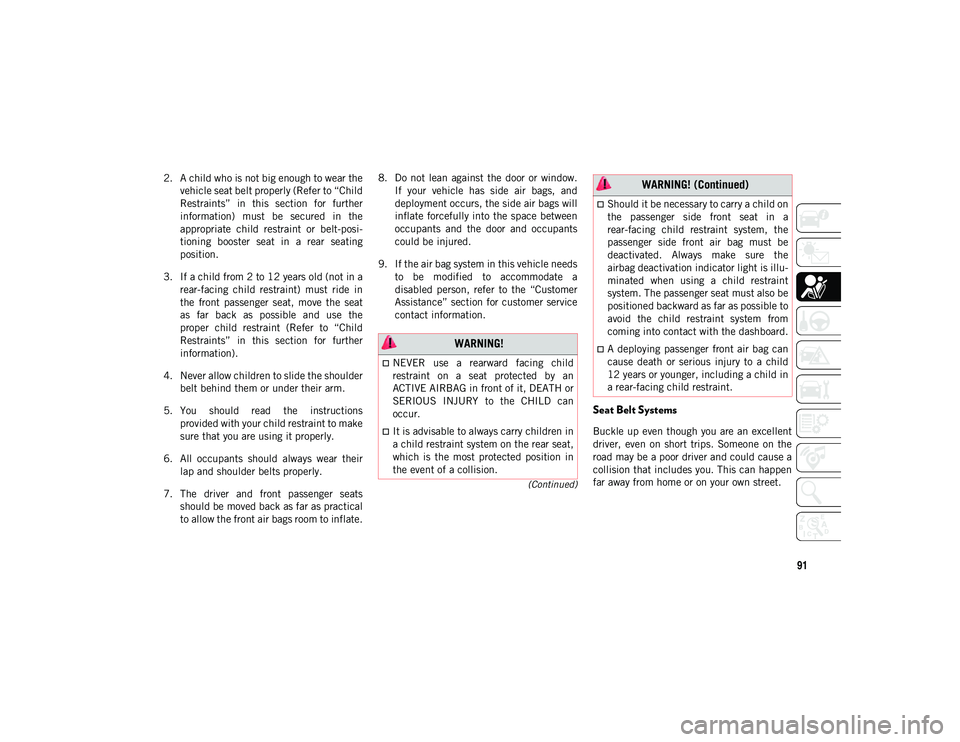
91
(Continued)
2. A child who is not big enough to wear thevehicle seat belt properly (Refer to “Child
Restraints” in this section for further
information) must be secured in the
appropriate child restraint or belt-posi -
tioning booster seat in a rear seating
position.
3. If a child from 2 to 12 years old (not in a rear-facing child restraint) must ride in
the front passenger seat, move the seat
as far back as possible and use the
proper child restraint (Refer to “Child
Restraints” in this section for further
information).
4. Never allow children to slide the shoulder belt behind them or under their arm.
5. You should read the instructions provided with your child restraint to make
sure that you are using it properly.
6. All occupants should always wear their lap and shoulder belts properly.
7. The driver and front passenger seats should be moved back as far as practical
to allow the front air bags room to inflate. 8. Do not lean against the door or window.
If your vehicle has side air bags, and
deployment occurs, the side air bags will
inflate forcefully into the space between
occupants and the door and occupants
could be injured.
9. If the air bag system in this vehicle needs to be modified to accommodate a
disabled person, refer to the “Customer
Assistance” section for customer service
contact information.
Seat Belt Systems
Buckle up even though you are an excellent
driver, even on short trips. Someone on the
road may be a poor driver and could cause a
collision that includes you. This can happen
far away from home or on your own street.
WARNING!
NEVER use a rearward facing child
restraint on a seat protected by an
ACTIVE AIRBAG in front of it, DEATH or
SERIOUS INJURY to the CHILD can
occur.
It is advisable to always carry children in
a child restraint system on the rear seat,
which is the most protected position in
the event of a collision.
Should it be necessary to carry a child on
the passenger side front seat in a
rear-facing child restraint system, the
passenger side front air bag must be
deactivated. Always make sure the
airbag deactivation indicator light is illu -
minated when using a child restraint
system. The passenger seat must also be
positioned backward as far as possible to
avoid the child restraint system from
coming into contact with the dashboard.
A deploying passenger front air bag can
cause death or serious injury to a child
12 years or younger, including a child in
a rear-facing child restraint.
WARNING! (Continued)
2020_JEEP_M6_UG_UK.book Page 91
Page 99 of 328
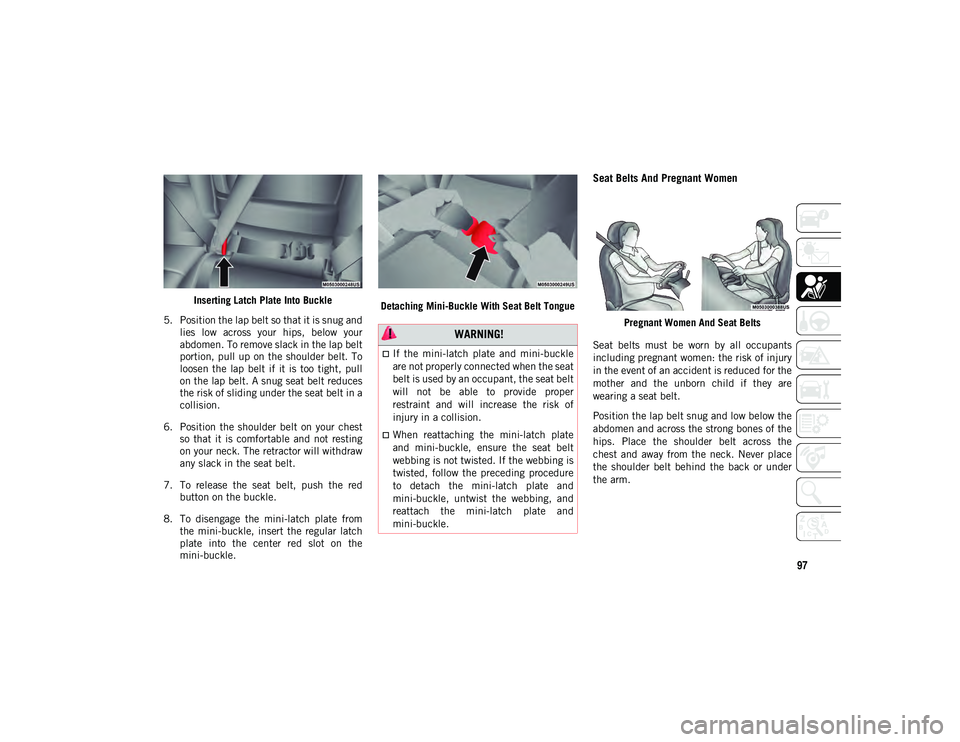
97
Inserting Latch Plate Into Buckle
5. Position the lap belt so that it is snug and lies low across your hips, below your
abdomen. To remove slack in the lap belt
portion, pull up on the shoulder belt. To
loosen the lap belt if it is too tight, pull
on the lap belt. A snug seat belt reduces
the risk of sliding under the seat belt in a
collision.
6. Position the shoulder belt on your chest so that it is comfortable and not resting
on your neck. The retractor will withdraw
any slack in the seat belt.
7. To release the seat belt, push the red button on the buckle.
8. To disengage the mini-latch plate from the mini-buckle, insert the regular latch
plate into the center red slot on the
mini-buckle. Detaching Mini-Buckle With Seat Belt Tongue
Seat Belts And Pregnant Women
Pregnant Women And Seat Belts
Seat belts must be worn by all occupants
including pregnant women: the risk of injury
in the event of an accident is reduced for the
mother and the unborn child if they are
wearing a seat belt.
Position the lap belt snug and low below the
abdomen and across the strong bones of the
hips. Place the shoulder belt across the
chest and away from the neck. Never place
the shoulder belt behind the back or under
the arm. WARNING!
If the mini-latch plate and mini-buckle
are not properly connected when the seat
belt is used by an occupant, the seat belt
will not be able to provide proper
restraint and will increase the risk of
injury in a collision.
When reattaching the mini-latch plate
and mini-buckle, ensure the seat belt
webbing is not twisted. If the webbing is
twisted, follow the preceding procedure
to detach the mini-latch plate and
mini-buckle, untwist the webbing, and
reattach the mini-latch plate and
mini-buckle.
2020_JEEP_M6_UG_UK.book Page 97
Page 100 of 328
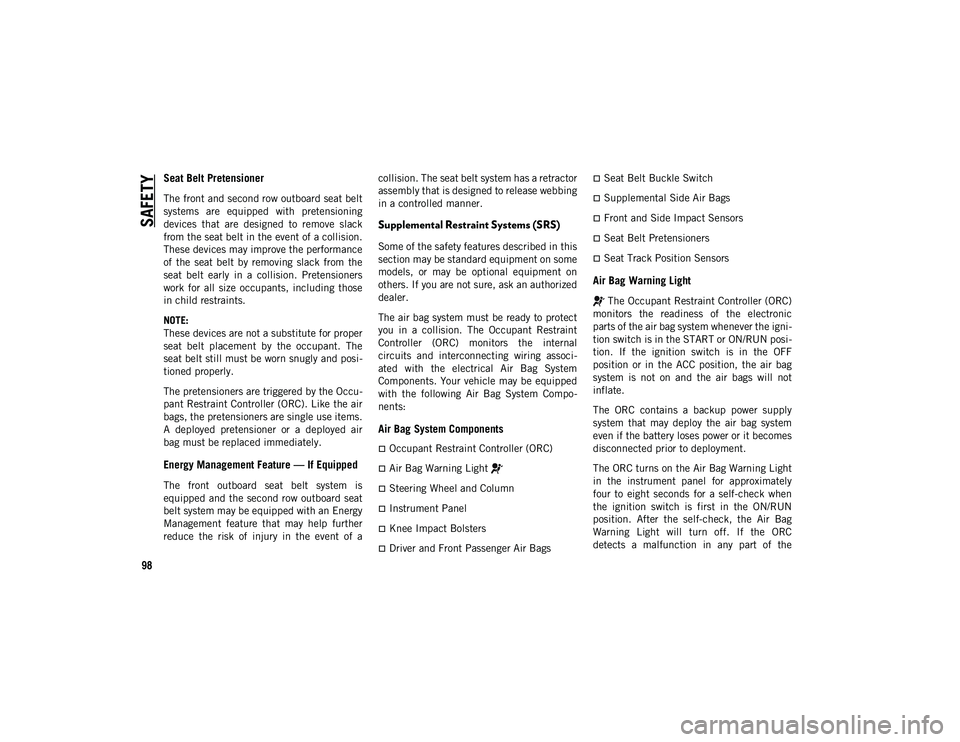
SAFETY
98
Seat Belt Pretensioner
The front and second row outboard seat belt
systems are equipped with pretensioning
devices that are designed to remove slack
from the seat belt in the event of a collision.
These devices may improve the performance
of the seat belt by removing slack from the
seat belt early in a collision. Pretensioners
work for all size occupants, including those
in child restraints.
NOTE:
These devices are not a substitute for proper
seat belt placement by the occupant. The
seat belt still must be worn snugly and posi-
tioned properly.
The pretensioners are triggered by the Occu -
pant Restraint Controller (ORC). Like the air
bags, the pretensioners are single use items.
A deployed pretensioner or a deployed air
bag must be replaced immediately.
Energy Management Feature — If Equipped
The front outboard seat belt system is
equipped and the second row outboard seat
belt system may be equipped with an Energy
Management feature that may help further
reduce the risk of injury in the event of a collision. The seat belt system has a retractor
assembly that is designed to release webbing
in a controlled manner.
Supplemental Restraint Systems (SRS)
Some of the safety features described in this
section may be standard equipment on some
models, or may be optional equipment on
others. If you are not sure, ask an authorized
dealer.
The air bag system must be ready to protect
you in a collision. The Occupant Restraint
Controller (ORC) monitors the internal
circuits and interconnecting wiring associ
-
ated with the electrical Air Bag System
Components. Your vehicle may be equipped
with the following Air Bag System Compo -
nents:
Air Bag System Components
Occupant Restraint Controller (ORC)
Air Bag Warning Light
Steering Wheel and Column
Instrument Panel
Knee Impact Bolsters
Driver and Front Passenger Air Bags
Seat Belt Buckle Switch
Supplemental Side Air Bags
Front and Side Impact Sensors
Seat Belt Pretensioners
Seat Track Position Sensors
Air Bag Warning Light
The Occupant Restraint Controller (ORC)
monitors the readiness of the electronic
parts of the air bag system whenever the igni -
tion switch is in the START or ON/RUN posi -
tion. If the ignition switch is in the OFF
position or in the ACC position, the air bag
system is not on and the air bags will not
inflate.
The ORC contains a backup power supply
system that may deploy the air bag system
even if the battery loses power or it becomes
disconnected prior to deployment.
The ORC turns on the Air Bag Warning Light
in the instrument panel for approximately
four to eight seconds for a self-check when
the ignition switch is first in the ON/RUN
position. After the self-check, the Air Bag
Warning Light will turn off. If the ORC
detects a malfunction in any part of the
2020_JEEP_M6_UG_UK.book Page 98
Page 102 of 328
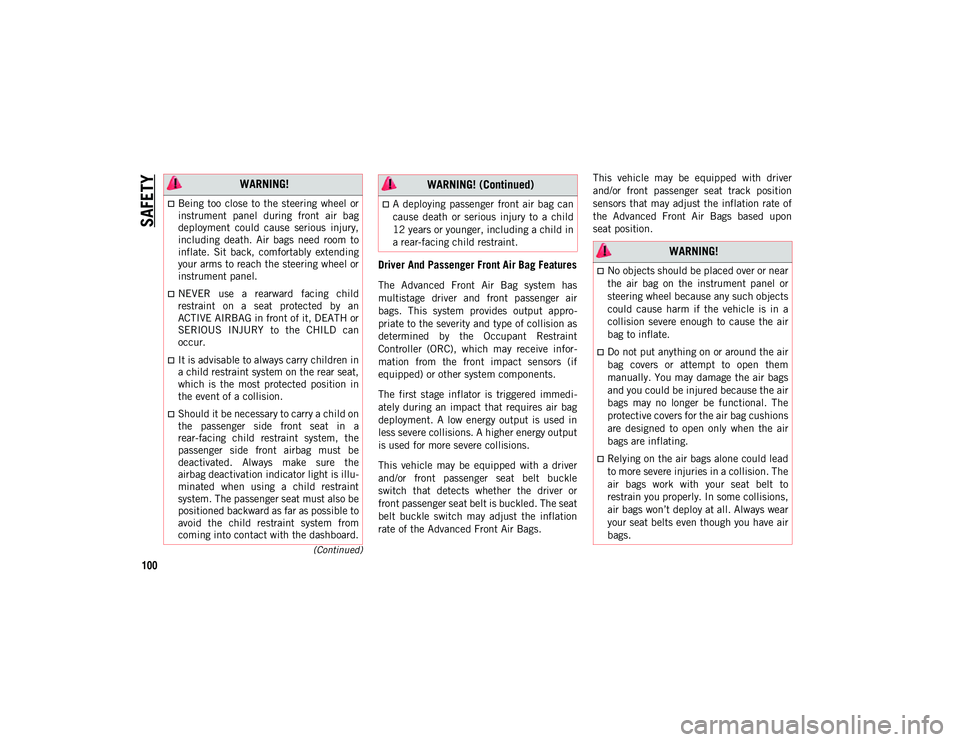
SAFETY
100
(Continued)
Driver And Passenger Front Air Bag Features
The Advanced Front Air Bag system has
multistage driver and front passenger air
bags. This system provides output appro-
priate to the severity and type of collision as
determined by the Occupant Restraint
Controller (ORC), which may receive infor -
mation from the front impact sensors (if
equipped) or other system components.
The first stage inflator is triggered immedi -
ately during an impact that requires air bag
deployment. A low energy output is used in
less severe collisions. A higher energy output
is used for more severe collisions.
This vehicle may be equipped with a driver
and/or front passenger seat belt buckle
switch that detects whether the driver or
front passenger seat belt is buckled. The seat
belt buckle switch may adjust the inflation
rate of the Advanced Front Air Bags. This vehicle may be equipped with driver
and/or front passenger seat track position
sensors that may adjust the inflation rate of
the Advanced Front Air Bags based upon
seat position.
WARNING!
Being too close to the steering wheel or
instrument panel during front air bag
deployment could cause serious injury,
including death. Air bags need room to
inflate. Sit back, comfortably extending
your arms to reach the steering wheel or
instrument panel.
NEVER use a rearward facing child
restraint on a seat protected by an
ACTIVE AIRBAG in front of it, DEATH or
SERIOUS INJURY to the CHILD can
occur.
It is advisable to always carry children in
a child restraint system on the rear seat,
which is the most protected position in
the event of a collision.
Should it be necessary to carry a child on
the passenger side front seat in a
rear-facing child restraint system, the
passenger side front airbag must be
deactivated. Always make sure the
airbag deactivation indicator light is illu
-
minated when using a child restraint
system. The passenger seat must also be
positioned backward as far as possible to
avoid the child restraint system from
coming into contact with the dashboard.
A deploying passenger front air bag can
cause death or serious injury to a child
12 years or younger, including a child in
a rear-facing child restraint.
WARNING! (Continued)
WARNING!
No objects should be placed over or near
the air bag on the instrument panel or
steering wheel because any such objects
could cause harm if the vehicle is in a
collision severe enough to cause the air
bag to inflate.
Do not put anything on or around the air
bag covers or attempt to open them
manually. You may damage the air bags
and you could be injured because the air
bags may no longer be functional. The
protective covers for the air bag cushions
are designed to open only when the air
bags are inflating.
Relying on the air bags alone could lead
to more severe injuries in a collision. The
air bags work with your seat belt to
restrain you properly. In some collisions,
air bags won’t deploy at all. Always wear
your seat belts even though you have air
bags.
2020_JEEP_M6_UG_UK.book Page 100
Page 103 of 328
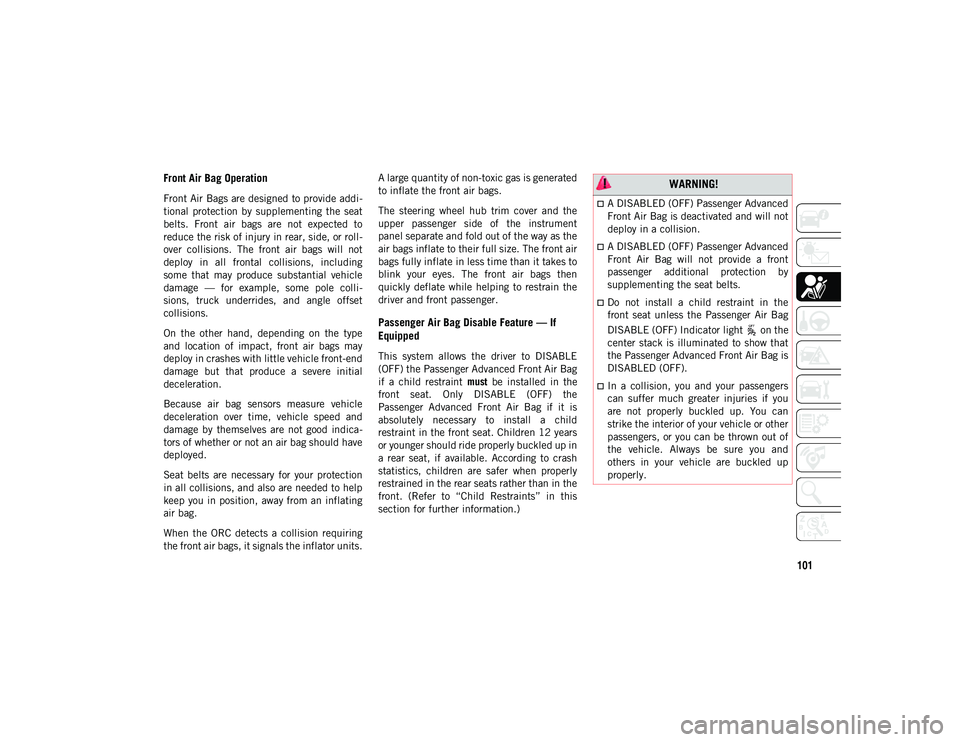
101
Front Air Bag Operation
Front Air Bags are designed to provide addi-
tional protection by supplementing the seat
belts. Front air bags are not expected to
reduce the risk of injury in rear, side, or roll -
over collisions. The front air bags will not
deploy in all frontal collisions, including
some that may produce substantial vehicle
damage — for example, some pole colli -
sions, truck underrides, and angle offset
collisions.
On the other hand, depending on the type
and location of impact, front air bags may
deploy in crashes with little vehicle front-end
damage but that produce a severe initial
deceleration.
Because air bag sensors measure vehicle
deceleration over time, vehicle speed and
damage by themselves are not good indica -
tors of whether or not an air bag should have
deployed.
Seat belts are necessary for your protection
in all collisions, and also are needed to help
keep you in position, away from an inflating
air bag.
When the ORC detects a collision requiring
the front air bags, it signals the inflator units. A large quantity of non-toxic gas is generated
to inflate the front air bags.
The steering wheel hub trim cover and the
upper passenger side of the instrument
panel separate and fold out of the way as the
air bags inflate to their full size. The front air
bags fully inflate in less time than it takes to
blink your eyes. The front air bags then
quickly deflate while helping to restrain the
driver and front passenger.
Passenger Air Bag Disable Feature — If
Equipped
This system allows the driver to DISABLE
(OFF) the Passenger Advanced Front Air Bag
if a child restraint
must be installed in the
front seat. Only DISABLE (OFF) the
Passenger Advanced Front Air Bag if it is
absolutely necessary to install a child
restraint in the front seat. Children 12 years
or younger should ride properly buckled up in
a rear seat, if available. According to crash
statistics, children are safer when properly
restrained in the rear seats rather than in the
front. (Refer to “Child Restraints” in this
section for further information.)
WARNING!
A DISABLED (OFF) Passenger Advanced
Front Air Bag is deactivated and will not
deploy in a collision.
A DISABLED (OFF) Passenger Advanced
Front Air Bag will not provide a front
passenger additional protection by
supplementing the seat belts.
Do not install a child restraint in the
front seat unless the Passenger Air Bag
DISABLE (OFF) Indicator light on the
center stack is illuminated to show that
the Passenger Advanced Front Air Bag is
DISABLED (OFF).
In a collision, you and your passengers
can suffer much greater injuries if you
are not properly buckled up. You can
strike the interior of your vehicle or other
passengers, or you can be thrown out of
the vehicle. Always be sure you and
others in your vehicle are buckled up
properly.
2020_JEEP_M6_UG_UK.book Page 101